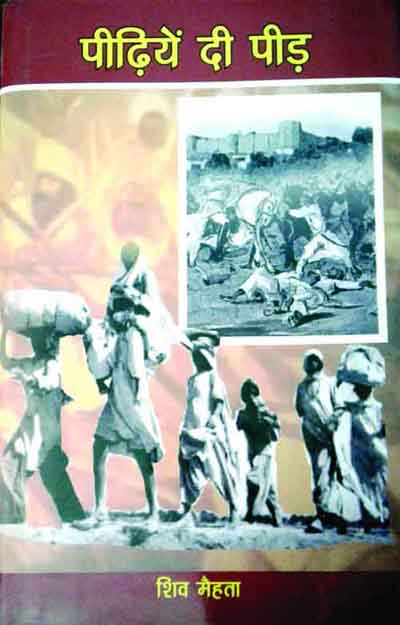Suman K Sharma
Acclaimed Dogri writer, Shiv Mehta’s latest work, Peediyen di Peed (Highbrow Publications, Bari Brahmana, Jammu), may well be cited as an illustration of a complete novel, going by what Anthony Burgess says of the genre. It is a prose narrative of beguiling invention. It has rather an imposing length of over a lakh words in its 488 pages. The complexities that turn up at page after page in the novel deal with a gamut of human experience. The saga effectively spans 300 years (1650-1950) in which twelve generations of men, women and children go through an intricate meshwork of sequences in a charged setting of Jammu and the undivided Punjab. Significantly, the whole novel revolves around one Sanskrit aphorism which is quoted by the author in the Preface (p.5). Rendered into English, it says something like this: you can’t escape savouring the sweet and bitter of your deeds, good or bad.
Mehta, though, seems to believe with the ancients that the cosmic justice is much harsher than what we mortals have thought up for ourselves. A brahmhatya – killing of a Brahmin – is a sin ghastly enough to invite severest punishment not only on the perpetrator but many many generations that follow him. Strongman Bangi kills Ranpat, the purohit of his clan on a personal grudge. Ranpat’s distraught mother, Alma, immolates herself with his lifeless body. Death imbues the mother-son duo with spectral powers. Ranpat becomes Data Ranpat and his mother, a sati. Bangi flees from his home to escape their ire, only to return with galloping leprosy and die a lonely, miserable death. Soon after, the pubescent sons of Bangi’s kin start dying of a strange disease. The damned clansmen lose their lands, their homesteads and their identities. Ending up as wanderers, lowly artisans, peasants and miners, they eke out a living in and around the Khewda salt mines of Punjab.
Fate brings one of the couples – Bounso and Taro – to Sukkho Chak, where they find shelter in the cowshed of an issueless Brahmin widow, Tai Manglo. It is here that a son is born to the couple in the year 1850. Eighth in the line of Bangi’s descent, the infant is given the nickname of ‘Sangi’ for his propensity to keep his legs raised like the prongs of a farming implement of that name. Sangi, like his progenitor Bangi, grows up to be evil incarnate. The one passion that he has is to pile up money (he is loath to spend it even on himself). For this passion he literally smashes and smothers to death anyone who comes in his way, not sparing even his diehard benefactor, Madan Shah. Fittingly enough, it is this mingy habit of his that brings him to his doom. He is exposed for what he is and sent to the gallows.
Sangi’s four descendants – Rajkumar, Surjo, Dhanno and Tara, in that order – too are afflicted with fatal flaws. Raj Kumar is perpetually emaciated with nose-bleeding, Surjo gets fits, Dhanno is born with ineffectual arms and the last one, Tara, though gifted with a sound body and the wherewithal to spend a normal life, is gullible to a fault. An adolescent entangled irrevocably in the charms of a rapacious courtesan almost twice his age, Tara is drowned in a flood, but not before he throttles to death the deceitful temptress. With his death, the curtain is finally drawn on Bangi’s progeny of twelve generations:
Chronologically, the well-structured novel can be split into three parts: the first (Chapters 1-8) harks back to prehistoric times when an Ayodhya prince, Agni Gard, established the kingdom of Jammu. It concludes with the death of Bangi around 1650 AD. The second part (Chapters 9-37) deals with dispersion of the accursed clan of Bangi and Sangi’s execution in 1850. The third part (Chapters 38-59), spans the tumultuous period of 1850-1950, delineating the fate of the last four generations connected with Bangi’s lineage.
Such a big canvass necessarily calls for a whole lot of characters, incidents and locales. The novel has no single hero around whom the narrative could be built up. Instead, every major character plays his or her part and gives way to another as the novel proceeds. Yet, the author has been able to achieve a compelling unity of purpose. Bangi kills Ranpat and the pool by which the victim’s body is discovered is sanctified as Daate da Talaa (The Tank of the Munificent One). Three hundred years and countless happenstances later, Tara dies in his attempt to reach the holy spot, as if to atone for the dastardly act of his progenitor.
The novel, though based on the Karma theory, does not easily give way to deus ex machina. If Bangi gets leprosy, it is because he is infected by a leper whose company he willingly seeks. Sangi turns a self-centred urchin because of the overindulgence of the issueless Tai Manglo. The inordinate love for money he displays during his adult years can be traced back to the goading of his parents, who are keen to distract him from his riotous ways. In the universe of Peediyen di Peed, most things that happen have an earthly explanation rather than the all-purpose karma.
That said, Peediyen di Peed is not an easy read. The problem lies with Mehta’s peculiar style. One is reminded here of TS Eliot’s famous quote about Djuna Barness’ Nightwood. The prose in the novel “is altogether alive”, he said, but also “demanding something of a reader that the ordinary novel-reader is not prepared to give.”


